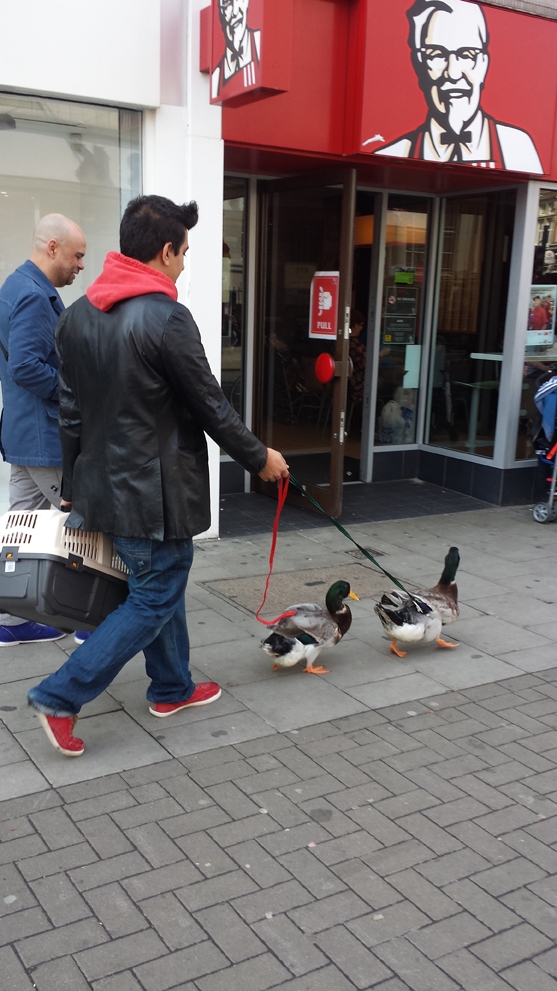I went viral, and I liked it. I posted a picture on Twitter of a man taking a pair of ducks for a walk along Rye Lane, Peckham. The ducks were on leads and totally unflustered as they waddled past a KFC. Equally unruffled were the good people of South London. Maybe, now that the area is peppered with experimental art-spaces, this is standard contemporary Peckhamism. Five hundred retweets later, I was fielding calls from the kind of media I usually only dream of reaching: Daily Mirror, Metro, London Evening Standard, The Telegraph and Time Out all wanted a piece of this surreal street scene.
The photograph came as part of a research trip for the British Pavilion’s show (which I’m cocurating) about postwar architecture and planning for this summer’s Venice Architecture Biennale: not the obvious source of a lighthearted news story. The exhibition will describe how architecture and planning constructed new visions of a Britain facing the raging forces of modernity. From William Blake’s ‘Satanic Mills’, through postwar reconstruction and the New Towns, to the bleak images of Joy Division in front of the Hulme Estate and Cliff Richard rollerskating ecstatically around Milton Keynes Shopping Centre in the video for Wired for Sound (1981).
Seeing ducks in fried-chicken-shop urbanism mixes up our expectations of place. It short-circuits what we think the words ‘city’ and ‘country’ should designate
It’s also an exhibition concerned with now: about how new forms of modernity are creating crises in our own cities, and about how architecture and planning might once again be a means of imagining new ways of living. This is where the duck-walking man, the cacophony of social media ‘likes’ and serious urban thinking intersect. Behind the surreal amusement was something more profound. Seeing ducks in fried-chicken-shop urbanism mixes up our expectations of place. It short-circuits what we think the words ‘city’ and ‘country’ should designate.
The image also talks to the long-standing tradition of rus in urbe (the country in the city). The estates set out by the aristocracy in the eighteenth century, for example, brought a piece of the countryside to the parts of the city they were laying out; the Georgian squares of London forming a vestigial trace, or perhaps more accurately reminder, of the intrinsic relationship between aristocracy and the ownership of the landscape.
Much later came the Garden City; instead of the binary opposition of ‘city’ and ‘countryside’, Ebenezer Howard imagined a third way, somewhere that could draw the best of each: the health and beauty of the countryside with the opportunity and sociability of the city (rather than, say, being unemployed and lonely in beautiful surroundings). We might call this rus et urbe: the city and country simultaneously.
Later still, techno-hippies began to imagine gadgets, gizmos and equipment returning us to the pastoral: Reyner Banham pictured houses that were simply augmented pieces of landscape: purple glowing rocks that emitted groovy domestic vibes. Archigram imagined things that looked like logs that we could plug into as nodes of power and communication, rendered with such fantastic technological precision that they looked more like nature than nature itself.
Howard envisaged the success of Garden Cities in turn transforming the centres of the industrial city. Their slums would depopulate, the dirt and squalor transform to greenery. Yet the ducks tell us a different story of the rus in urbe, the real story of what happened to the centre of the city.
Since the 1960s, places considered slums a generation before – irredeemable and slated for demolition – have become desirable. The metropolitan centre, rather than leafy suburban dispersal, has become the archetypal urban vision for the upwardly mobile middle-class. Bubble after bubble, the centre of the city has turned into exclusive domains of village-in-city gentrified imagination – shopping parades nostalgic for a nonexistent past: specialist cheese shops, artisan bakers and craft-based producers, past which we cycle on our retro bicycles, wicker baskets lashed to the handlebars, on our way to the farmers’ market.
Contemporary modernity’s real effect on our cities is to render them less equal, less affordable, less accessible: they begin to exclude their own citizens, and in doing that, they kill the very idea of the city. Meanwhile, out in the country, mega-malls nestle among strategic tree planting, their fibreglass-Victoriana clocktowers poking above the treeline as their backlit signs glimmer between the leaves. The country channels modernity in ways that the inner-city villages try to resist. Yet beyond these two options – the stalemate of contemporary urbanism – there may be something far more exciting. Something embodied by the duck-walking man and his instant media profile; an electric jump-start to Howard’s Edwardian vision; a place where modernity’s transformational power might supercharge radical collages of lifestyle.
This article was first published in the Summer 2014 issue
